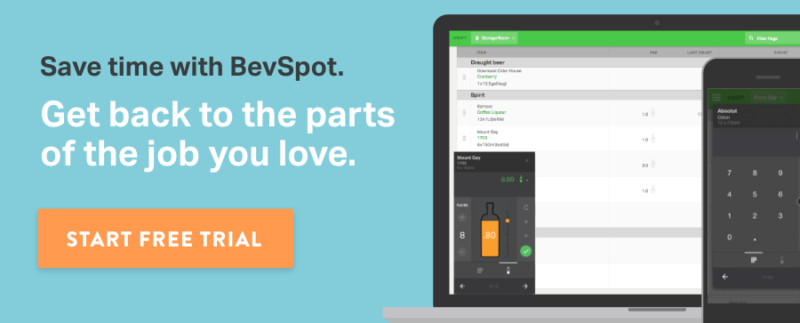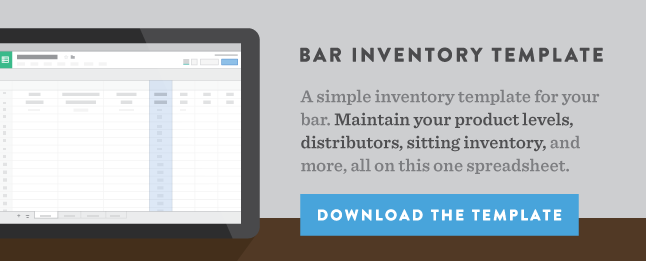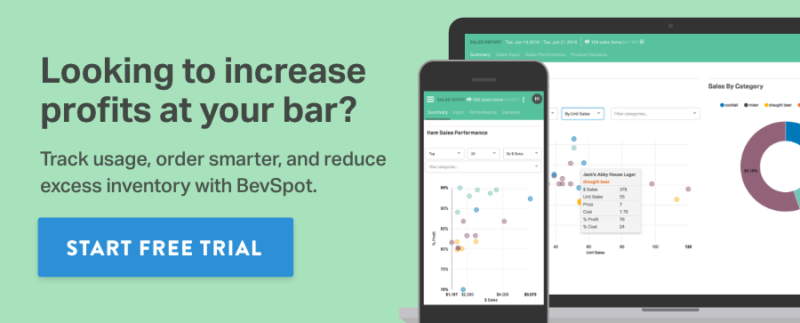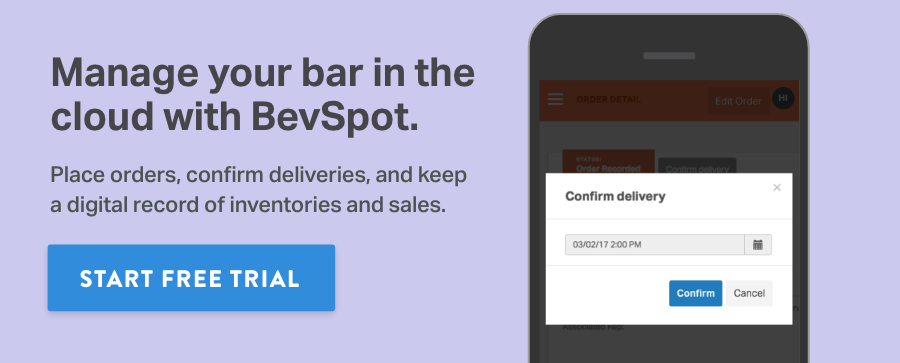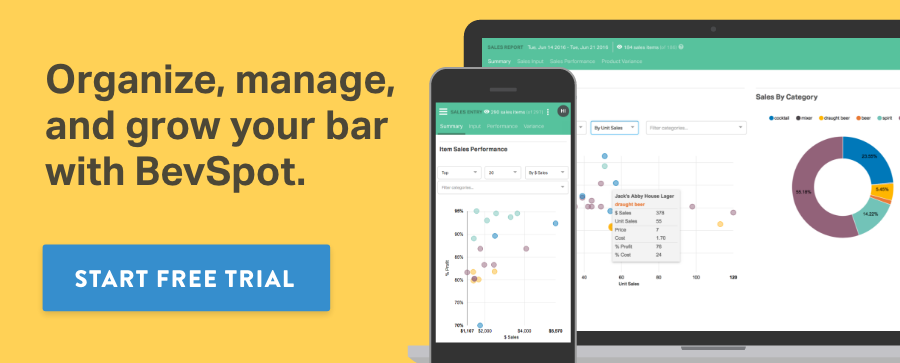Tips For Bar Managers: How To Get Hours Back In Your Day
Tips For Bar Managers
The life of a bartender: getting home in the middle of the night after working a long Saturday night shift. Rolling out of bed early the next morning to start counting bottles. Crunching numbers, sorting papers, and placing orders across multiple distributors. And all the while, constantly pleading: ‘if only there was more time in the day!.
What if there was?
Bevspot’s tools allow users to gain back valuable time typically spent on counting bottles and inputting numbers into Excel.
The value of time is a big topic of discussion around here, especially with the industry experts on our team. Chris Bobola, former bar manager at Lincoln Tavern in Southie, is a true BevSpot expert, having experience both as a user while working at Lincoln, and now as an asset to the BevSpot Business Development team.
I sat down with Chris to discuss what it actually felt like to have more hours in the day while utilizing BevSpot at Lincoln, and what useful tasks can be done with all that extra time…
Menu
Chris: Having the extra time as well as the historical insights into our inventory allowed a strong grasp on how to better cater to Lincoln’s customer base. Using this information, our team was able to craft a more creative cocktail menu, catered directly to our clientele.
On the flip side, we were easily able to see the products with the lowest usage numbers and create weekly drink specials to help move that product faster.
Marketing
Chris: Having time to focus on marketing is extremely important, to any business. Even the most popular restaurants hit lulls and it’s important to have the time to work with the team on marketing promotions that drive more customers during slower times. Deals and theme nights are a great way to do this, and not spending so many hours on inventory gave us the flexibility to organize and execute on these ideas.
Operations
Chris: A restaurant is only as good as its staff! Putting the time in to prospect, interview, and hire the best is essential, but beyond that, training and really motivating the team makes for happy customers. We were able to schedule much more meaningful educational trainings for staff, enabling servers and bartenders to become more knowledgeable about the food and cocktails served.
Staff scheduling is another one of those restaurant managerial tasks that is not fun. So having the time to really put into a well-planned schedule makes for more efficient operations—less call-outs and coverage requests. It also helps ensure that prep work, openings, and shift turnovers run smoothly.
Face Time
Chris: In our digital world, it’s easy to overlook the importance of good old fashion schmoozing! Having the time (and energy) allows for more efficient meetings with sales reps to really learn about, and taste products for your establishment.
And, most importantly, time to interact and socialize with the guests! The food and booze may be up to par, but there is so much more that goes into rounding out the overall customer experience.
Find out more Tips For Bar Managers here:
Schedule 15mins to chat with a product specialist
Start a FREE Trial Today! BevSpot offers full product education and account setup for all customers! No card Information needed!
Setting Pars
We recently covered how efficient inventory management starts with a simple, yet critical calculation: an inventory usage report. You can get this report instantly in BevSpot, or manually with a spreadsheet like the one we’ve made. Now that we know how to calculate usage, let’s dig into what you can do with your usage report.
One useful way to utilize an inventory usage report is to set pars. Pars represent the minimum amount of product that a bar would like to keep in stock at all times. By setting pars, you can immediately tell when inventory levels for a certain item need to be reordered.
While well-run bars use pars to ensure they never run out of product, accurate par setting can also ensure that your bar is not sitting on too much inventory, which ties up valuable cash for the business.
Pars are affected by seasonality and changing consumer preferences, so at a minimum, they should be updated twice per year: during a busy season and during a slow season. For more accurate inventory management, they can also be updated more frequently (quarterly, monthly).
How to Calculate (and Set) Par Levels
To set accurate pars for your bar, follow these steps:
Step 1: Look at your Historical Usage
Calculate your historical (several month) item level usage for every item at the bar. Let’s assume for this example that over a 3-month period (13 weeks), you used 456 bottles of Harpoon IPA.
Step 2: Calculate your Average Weekly Usage
Divide your total historical usage by the number of weeks to calculate an average weekly usage. In our example, 456 bottles of Harpoon divided by 13 weeks equals 35 bottles per week.
Step 3: Factor in Seasonality
Account for seasonality by multiplying this average by a seasonality factor. If your initial historical usage calculation uses data from your slow season, consider the effects of heading into a busier season. Your busy season might be, on average, 50% busier, so you’ll want to multiply your initial average weekly usage calculation by 1.5. In our example, 35 bottles x 1.5 = 53 bottles per week.
Step 4: Set your Target Goal
Determine your target weeks of inventory to stock for the bar. We recommend staying lean and setting a goal of 2 weeks, to avoid overstocking, but each establishment is different and you’ll want to play with a target that works for your business. For a 2 week target par, take the seasonality adjusted weekly inventory of 53 bottles per week, and multiply it by 2 weeks of inventory. Your par is 106 bottles.
Easy enough, right? But remember, you need to repeat this process for every item at the bar…
BevSpot allows customers to set up pars instantly and cut ordering time from hours to minutes using Smart Cart. By setting your pars within BevSpot, you can easily see and add any items below par to your ordering cart with one click! BevSpot automatically tracks your inventory usage, enabling you to adjust your pars over time to ensure optimal inventory levels as seasonality and consumer preferences change.
With all the cash you’ll be putting back in your owner’s pocket, it may be time to start negotiating a raise…
Schedule 15mins to chat with a product specialist
Start a FREE Trial Today! BevSpot offers full product education and account setup for all customers! No card Information needed!
Three Ways to Think About Sitting Inventory
Sitting Inventory
Sitting bar inventory can often be overlooked as profitable products that are waiting to be sold. While the ultimate hope for all sitting inventory is that it will (at some point) convert to sales—the simple fact is that until it does, it represents critical components in your business.
The next time you’re looking at all those full bottles sitting on your shelves, consider them in terms of three important factors: money, risk, and time.
Money
Each unused wine, spirit, beer, and other bar-related product represents cash sitting on your shelves—unusable cash. Sitting inventory ties up costs: you can’t use it to buy more inventory, and it’s not immediately counting toward your profits.
Consider a bar that stocks $40,000 in inventory at any given time, and sells, on a cost basis, $10,000 of product each week (commonly referred to as “usage”).
Based on this usage-to-inventory ratio, this bar is sitting on four weeks worth of inventory. Imagine reducing that sitting inventory to $30,000. The bar now has three weeks worth of inventory (still a plentiful amount of product to have), and that $10,000 reduction will immediately return to the owner’s pocket, becoming available to pay for other business expenses such as rent and payroll. That’s much more useful than sitting on the shelves.
SEE HOW BEVSPOT CAN HELP YOUR BAR
Risk
Now that we’re in the mindset of seeing our sitting inventory as money, let’s consider the risk associated with that money.
Think about how you use cash on a personal level. Most likely, the bulk of your money is secure in a safe or in a bank account. When you go to an ATM, you probably don’t take out too much at a time. This is because most of us, at some point or another, have learned the difficult lesson that it’s never a good idea to walk around with too much cash. Maybe it was that time your wallet was stolen in Europe, or that night when you bought a round of drinks for… everyone at the bar. Either way we know, it is never fun to lose money.
Apply this same logic to your bar—that inventory sitting on your shelves is always at risk, risk of being broken, stolen, or mysteriously going missing. In this case, not only is your sitting inventory tying up cash that you could be putting back into your business, it’s actually increasing your costs and lowering your profits.
Time
Any bar manager will say that taking inventory is the most tedious and time-consuming part of the job. Each bottle, can, and keg represents the time required to count it each week or month.
By reducing your inventory, you’re also directly reducing the time required to take inventory, thus freeing up valuable hours to focus on more important activities that generate greater sales and profit for your business (or a few extra hours of much-needed sleep).
The next time you complete an inventory, think about the money, risk, and time your product represents and take active steps to reduce your inventory levels. This will improve your business by making it easier to manage, and generate greater profits. The most successful accounts we work with have the lowest levels of sitting inventory because they understand these dynamics and strive to run at the most efficient inventory levels possible.
Schedule 15mins to chat with a product specialist
Start a FREE Trial Today! BevSpot offers full product education and account setup for all customers! No card Information needed!
Tequila 101
The word ‘tequila’ tends to evoke a certain stream of thoughts into the average mind. Images of salt, limes, shots, spring break, and margaritas probably fall into the top 5 for most. For other, more extreme cases, memories of blackouts (or lack there of) and body shots bring out feelings of regret. Many think of tequila as the enemy.
With our college years and most of our tequila headaches far behind us, it’s time to overcome first impressions and past mistakes; for with a little maturity, enemies can easily become friends.
On a recent visit to one of our newest customers, Lolita, I decided to stray away from the delicious margaritas, mojitos, and sangria offered on the menu, and instead dove right into the various sipping tequilas:
Blanco
Also known as silver tequila, blanco is typically unaged. A mature palate for spirits will appreciate the pure flavor of distilled agave, with citrus notes, but it comes with a bite. The immature nature of blanco tequila can definitely be a slap in the face to many. But as with all spirits, no two are exactly the same. Some blancos are smoother than others. And if not, you can keep a lime handy.
Reposado
Next on the chain are reposado tequilas, which are aged anywhere from 2-12 months in oak barrels. The initial scent of a neat reposado will quickly make you question if it’s actually the same spirit as blanco, as it’s filled with strong caramel tones. It can still have that bite, but it comes along with a sweet finish.
Anejo
Any scotch lover will appreciate a fine anejo. Aged for multiple years in smaller oak barrels, anejos are the smoothest of the tequila types, often with nutty vanilla notes. To consider covering up these complex flavors with lime, salt, or sugared down margarita mix, would be a crime.
Not all bars have the selection that Lolita has, but next time you’re ordering a tequila, look beyond the options of silver or gold. The possibilities are endless, and staying away from sugary mixers can do wonders for that morning after headache.
Head over to Lolita in Back Bay, and ask about their tequila flights—a great place to start for a tequila novice:
Lolita Cocina and Tequila Bar
271 Dartmouth Street Boston, 02116
lolitatequilabars.com
4 Entrepreneurs, 1 Question: What’s the Most Helpful “No” You Ever Received?
BevSpot Co-Founder and CEO, Rory Crawford, connected with Rebecca Strong of Bostinno to discuss the most useful “no” he received, for an article on Boston entrepreneurs:
“When one door closes, another opens.” “Every ‘no’ gets you closer to a ‘yes.'” These common motivational quotes may sound cheesy, but there’s still some truth behind them that rings particularly relevant for entrepreneurs—especially during the process of raising funding. […]”
Yelp: A Restaurant’s Best Friend or Worst Nightmare?
Regardless of having actually written a review, we’ve all used Yelp. Perhaps the app is on your phone as the first place you turn when hunting down your next meal, or maybe it’s constantly popping up first on your Google search results. Either way, seeing that star rating has no doubt impacted a dining decision or two, in all of us.
From a consumer standpoint, Yelp’s role is clear: a convenient endless database of businesses, offering potentially unbiased accounts on anything from fine dining experiences to $10 haircuts. The tools have expanded in recent years, now allowing the ability to book a reservation or even order delivery. Questions like ‘do they have outdoor seating?’ and ‘is it too fancy to bring the baby?’ are easily answered by scrolling through photos, doing a quick review search, or applying certain filters.
Spreading the Word: A Threat to Restaurants?
To restaurants, the phrase ‘word of mouth’ has never been more apparent. Restaurants have, historically, turned to a tell-your-friends approach, usually combined with traditional advertising methods and professional restaurant critiques (often times pre-planned and well prepped for). But prior to the digital age, online foodies and pseudo restaurant critics didn’t exist. Possession of a phone or computer enables just about anyone to write a public restaurant review.
Along with this freedom comes consequences. At any moment, someone walks through the doors who, unbeknownst to you, is quite the online influencer. One bad experience results in an irrational rage review, thus driving down your entire overall rating.
Granting a public voice to anyone will always address the topic of integrity. A recent, locally infamous incident at Alden & Harlow quickly drew this topic to the media. Can Yelpers use their freedom of speech as a threat? Are people abusing the power?
Benefiting Restaurants and a Tourist Tool
Then, there’s the flip side, that Yelp provides a voice to those who are voiceless, patrons and restaurant owners alike. Take for example the small foodie town of Portland Maine. Upon a quick search on Yelp, the top rated restaurant comes up as Fishermen’s Grill, a tiny shack, off the beaten path of Portland’s main dining strip, but offering the most delicious (coming from personal experience) lobster rolls. Portland visitors have easy access to finding this hole-in-the-wall gem, and Fishermen’s Grill has a heavy flow of tourists pouring through its doors. Win-win.
A Dining Scene Shift
The age of Yelp also comes along with that shift in dining standards. For many, gone are the days of ambiance-centric dining choices, for true foodies live in a food-focused world. As in the case of Fishermen’s Grill, diners overlook the lack of views and decor for a delicious meal. To them, it’s not as much about the entire experience as it is about the food, because that food represents an opportunity—a photo op, blog content, and of course, a Yelp review.
The rapid pace in which food trucks entered into mainstream popularity further attests to the culinary shift. Any niche chef with a driver’s license can open a restaurant on wheels, and Yelpers are quick to jump on board and spread the word.
Love it or hate it, trust it or not, Yelp has transformed the restaurant industry. It’s opened many doors, and likely closed a few as well. A truly talented chef or mixologist easily reaps the benefits, while dodging those who abuse the power from time to time.
The culinary scene will always rely on word of mouth, and as technology evolves, so too does hearsay. Take it all in, but with a grain of salt.
Schedule 15mins to chat with a product specialist
Start a FREE Trial Today! BevSpot offers full product education and account setup for all customers! No card Information needed!
Toro, No. 9 Park and other top Boston restaurants are taking a chance on this startup
We connected with Sara Castellanos of the Boston Business Journal to discuss our recent Series A funding round of $5.25 million lead by Bain Capital Ventures, and our hiring plans:
“Greater Boston’s top restaurants including No. 9 Park, La Brasa and Toro Boston are taking a chance on BevSpot, which offers software to better track inventory, automate orders and boost efficiency.[…]”
Calculating Inventory Usage
Calculating Inventory Usage
Successful bar managers will tell you that efficient inventory management is the key to maintaining a profitable bar. To do this, you must understand inventory usage, or how much product a business has used over a time period.
Start Your Free Trial With Bevspot Today!
If your bar management software or inventory spreadsheets are set up correctly—we’ve got a bar inventory template for you if they’re not—you should be able to access an inventory usage report. That may sound simple, but this report is the first step in almost every measurement of a bar’s performance: helping you calculate profit margins or pour costs, detect over-pouring or theft, calculate pars, and find which products are performing poorly.
How to Calculate Inventory Usage
[See also: Bar Inventory and Usage for Beginners]
Let’s start with the inventory usage formula. Your inventory usage is equal to your starting inventory plus any received product orders minus your ending inventory:
Inventory Usage =
Starting Inventory
+ Received Product Orders
– Ending Inventory
Step 1: Take a ‘Beginning-of-Period’ Inventory
The first step for calculating inventory usage is recording your starting inventory for every item at the bar.
For example, if there are 4 bottles of Absolut Vodka in the liquor room, 1 bottle in storage, and 1.3 bottles at the main bar, then total starting inventory is 6.3 bottles.
Step 2: Add Any Received Product Orders During the Time Period
Next, we add in any received product inventory.
If 5 bottles were ordered and received from your distributor in the time between your starting and ending inventory, then this would represent your received inventory.
Step 3: Subtract Your ‘End-of-Period’ Inventory
The final step is to record an ending inventory for every item at the bar at the end of a time period (usually weekly or monthly).
For this example, let’s say we finished with an ending inventory of 3 bottles of Absolut Vodka.
So, Inventory Usage =
6.3 bottles (Starting Inventory)
+ 5 bottles (Received Product Orders)
– 3 bottles (Ending Inventory)
= 8.3 bottles
This can also be expressed in dollars. If Absolut Vodka costs the bar $15/bottle, then 8.3 bottles of inventory usage in dollars equals. ($15 x 6.3) + ($15 x 5) – ($15 x 3) = $124.50.
In this basic example, it seems very straightforward, but factor in the big picture of inventory usage and you’re looking at much more than just Absolut. Inventory usage will need to be broken down by category (spirits, wine, and beer), item type (vodka, whiskey, rum, etc.), and brand/supplier in order to get the best look at your bar’s performance.
That’s a lot of different calculations to be making on a regular basis!
And no matter how long you’ve been doing it and how much you understand the formula, without software automation, calculating inventory usage will always be a time-consuming and redundant task. Counting each bottle, recording it on paper, entering it into Excel, tracking and entering your received product from dozens of paper invoices and distributors, and keeping track of all of this on a weekly, monthly, quarterly basis…it’s never-ending!
Conclusion
Luckily, it doesn’t have to be so hard. [Shameless plug] BevSpot will automatically calculate your item-level usages over any time period for you! Simply place your alcohol orders across all of your product through our bar inventory app and complete your inventories in half the time directly on your phone or tablet.
Now for the real question…what will you do with all that extra time on your hands?
Schedule 15mins to chat with a product specialist
Start a FREE Trial Today! BevSpot offers full product education and account setup for all customers! No card Information needed!
Bar-focused software startup BevSpot knocks back $5.25 million in funding
We connected again with Scott Kirsner of BetaBoston and the Boston Globe to discuss our recent Series A funding round of $5.25 million lead by Bain Capital Ventures, and our progress since we spoke 10 months ago:
“Talk about seizing an opportunity: when Rory Crawford was a graduate student at Harvard Business School last spring, he set up a 30-minute videoconference with one of the school’s entrepreneurs-in-residence, Ajay Agarwal. Crawford wanted to discuss a startup idea with Agarwal, an investor at Boston-based Bain Capital Ventures who splits his time between Massachusetts and California.
Agarwal remembers a ‘smart, aggressive, scrappy entrepreneur trying to bring cloud software to a massive but sleepy old-school industry.’ […]”
3 Reasons Not To Open a Restaurant, and the 1 Reason You Should
What to know about opening a restaurant.
A 2003 study by Ohio State University found that 60% of restaurants fail within their first 3 years of operation, and 80% fail before the 5th year.
It may seem glamorous from the outside—providing delicious food, and drinks while creating a foundation for the fun experiences that enrich people’s lives on a daily basis. An ideal profession, right? But one deep look into the underlying business dynamics that go into running a restaurant provides insight into the incredibly high failure rates of the restaurant business.
Why Not?
1. Low Profit Margin
According to a 2014 study by Sageworks, average restaurant industry net profit margins in 2014 were just 5.1%, up from a low of 0.4% in 2008. For comparison, Google’s net profit margin has never fallen below 21%. Why such a contrast? Here are 3 of the biggest reasons:
- High competition: The sheer number of options consumers have limit the prices restaurants can charge
- High fixed costs: Incumbent rent, wage and ingredient costs suck profit out of every sale
- Lack of visibility: The one-off nature of every reservation leaves restaurants weekly at the whim of economic cycles, consumer trends and even bad weather
2. Extremely Complex Operations
While the beautiful plates of food and delicious cocktails delivered to the table may not seem all that complicated, the truth is that offering 20-100 different food options nightly and a near unlimited number of drink options to every single customer on a daily basis is extremely difficult.
The vast array of necessary ingredients required to create hundreds of unique products each night leads to high inventory costs, and the mere act of managing these hundreds or thousands of food and bar-related ingredients, all purchased weekly from different vendors, is an incredible logistical challenge when operating on low margins with limited cash resources and space for storage. Contrast these operational challenges with a company that sells, let’s say, software, and deals with only one set of customers all with a similar problem to solve, and the operational difficulties of running a restaurant become clear.
3. Long Hours and High Employee Turnover
Late nights…long weekend shifts…sleep deprivation. Sound familiar? You’ve probably worked in the restaurant industry. It’s not uncommon for the late night closing shift to bleed into the morning opening shift after 5 straight days of work. And we know, it’s not easy work!
Eight straight hours on your feet ends with locking the doors, closing out the register, bussing tables, and preparing for the next morning, when you’ll be doing it all over again. Add on 5-15 hours of weekly or monthly inventory counts, product ordering, sales reconciliations, and profitability analyses, and your end result often comes out to 60+ hour workweeks.
And the worst part? This grind makes it near impossible for managers and owners to retain good talent, thus leading to constant recruiting and training of new personnel that will likely leave as well. A vicious cycle indeed.
So, Why Should You Open a Restaurant?
Yes, it’s a challenging industry. But is anything more rewarding than providing people with those wonderful life experiences centered on food and drink?
Birthdays, promotions, engagements—what’s the first thing people do when they have something to celebrate? Make a reservation of course! Though a difficult industry, it’s also an industry that never dies. Volatile, yes, but the right concept and operational efficiencies can, in fact, withstand the test of time. And to have people seek out your business to celebrate life’s greatest moments is truly a unique feat.
The best part of all is that we are living in the age of technology, and, like most industries, utilizing new technology can directly address the business challenges laid out here. With the proper tools and inventory management, you now have the ability to strengthen your operations and identify your weaknesses before they become a problem, so you can ensure that your restaurant won’t become one of the 60%, or 80%!
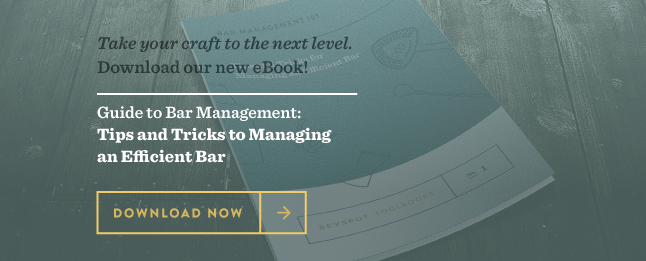
Schedule 15mins to chat with a product specialist
Start a FREE Trial Today! BevSpot offers full product education and account setup for all customers! No card Information needed!
Introducing New Products that Save $ and More
BevSpot was recently featured in the article Introducing new products that save $ and more in FoodserviceEast:
“… a new way of beverage product ordering and management that is twice as fast as older methods and can bring major savings to restaurant beverage managers as well as simplifying ordering, inventory and more.”
Harpoon Co-Founder Backs Booze Management Startup BevSpot

We recently spoke with Rebecca Strong at BostInno about our progress and news of our newest investor:
“Shortly after it was founded, BevSpot raised $20,000 from the student-run Dorm Room Fund, and following its product launch in August, the company banked a $700,000 seed funding round. Now, Crawford revealed that Harpoon Brewery co-founder Rich Doyle invested in BevSpot at the end of 2014, and is now also acting as a strategic advisor for the startup.”
Read the full article on BostInno →
Related articles from BevSpot
Introducing the Redesigned Inventory Experience
2016 Beverage Industry Trends You Need to Know
Cloud software for bars & restaurants
3 Steps to Building a Product Portfolio
New Platform Bridges Alcohol Distribution, Retail
We recently sat down with Raghu Dhara from the Crimson to talk about BevSpot and our plans for the future:
“For alcohol retailers, Boston’s brews are now just a few clicks away. BevSpot, a nascent online software platform formed by Harvard affiliates to help enable licensed alcohol distributors to sell their products to restaurants and bars, recently received $720,000 in seed funding to develop its services.
Founded last March, Bevspot helps its clients manage their inventories, allows them to order from a broad distributor base, and provides them with business analytics. […]”
BevSpot banks $720,000 to help bars and restaurants better manage their booze
We recently spoke with Scott Kirsner of BetaBoston about our business model, vision, and recent seed funding:
“2014 has been a pretty action-packed year thus far for BevSpot: founded in March by Harvard Business School and MIT students…raised $20,000 in early funding shortly after by the student-run Dorm Room Fund…product launch in August…and now, a $700,000 seed funding round.”
